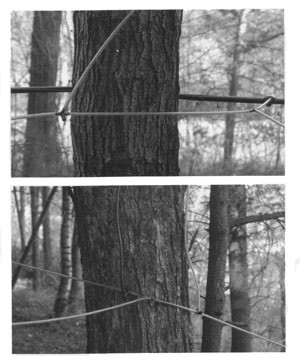Does Sugaring with a Vacuum Pump Hurt the Trees?
Sap flows out of tap holes in sugar maples when the spring days are warm and the nights are freezing, because those conditions make the pressure on the sap inside the trees higher than the air pressure outside the trees. The bigger the difference between inside pressure and outside pressure, the greater the rate of sap flow and the better life is for sugarmakers. But this pressure gradient can vary quite a lot from day to day.
Think of a water balloon. When filled, the water inside exerts an outward pressure on the balloon greater than the pressure exerted by the atmosphere outside. Put a hole in the balloon, and water comes out. Sap flow in maples is similar. But trees are not just sacks of water; they are complex cellular beings, and so sap drips more than squirts out of them. After dripping for some time, there’s less sap and less pressure inside and the run subsides. Freezing temperatures at night can recharge the sap pressure in the tree (by causing it to suck water up from the soil), and when we get those stretches of successive warm days with freezing nights, we get really strong runs.
Without that continuing freeze-thaw cycle, though, a good run can turn into a bad run within just a few hours. By the second or third day of warm days without freezing nights, the pressure difference becomes negligible and so too does the rate of sap flow. Under these conditions, if you’re collecting sap by gravity alone, you will find very little, if anything, in your lines or your buckets.
There’s not much a sugarmaker can do to increase the pressure inside the stem. That’s up to the anatomy of sugar maples and the weather outside. But while freezing air outside can increase the pressure inside significantly, even a low-pressure front moving in doesn’t really lower the outside air pressure enough to increase sap flow. So, instead, many sugarmakers use vacuum pumps on their tubing systems to artificially reduce the air pressure outside the tree. This increases the inside-outside difference and, thereby, the sap flow. This way, even if the pressure inside the tree is minimal, sugarmakers can still get sap to flow because the air in the tubes connected to the trees is under suction (negative pressure), creating that all-important gradient between inside and outside pressure – in this case by use of a vacuum pump installed at the sap tank that applies suction throughout the entire tubing system.
Anyone who cares about tree health – sugarmakers certainly among them – wants to know just how much you can lower the outside pressure using a vacuum pump without damaging the tree or perhaps altering the quality of the sap or syrup. Some have speculated over the years that too much vacuum could damage trees by actually sucking wood cell contents out into the tubing or perhaps dilute sap by pulling more water out of the tree. These are serious issues, for sure, and there are lots of opinions about them. Recently, Tim Wilmot, University of Vermont Extension Maple Specialist, and his colleagues at the Proctor Maple Research Center in Underhill, Vermont, have addressed these questions more scientifically.
Their experiments are designed to see how collecting sap under various levels of vacuum (and no vacuum) affects tree physiology and sap quality. “We found no differences in sap chemistry, suggesting there was no cellular destruction,” said Wilmot. “And we found no differences in sugar content, indicating that the sap was not diluted by vacuum.” Wilmot and crew also cut down a number of trees and sectioned their stems to examine tap hole wounds and the trees’ responses to them. Again, they found no differences among any of the levels of vacuum or nonvacuum. Did they find any differences at all? “Yes,” said Wilmot. “We found that the volume of sap collected was directly proportional to the amount of vacuum applied,” he said. “In other words, the more vacuum applied, the more sap collected.”
This is good news. But it’s not necessarily the last word in the story. Wilmot’s study was only conducted during one season, so it does not yet speak to potential long-term effects of using vacuum in the maple woods. Given that tubing systems with vacuum can often double the yield over gravity/bucket systems, sugarmakers, scientists, and tree lovers of all stripes are smart to wonder what proportion of the trees’ total sap is being harvested and what effect the extra harvest enabled by vacuum might have on long-term health of the sugar woods. Tim Wilmot and others continue to watch.


